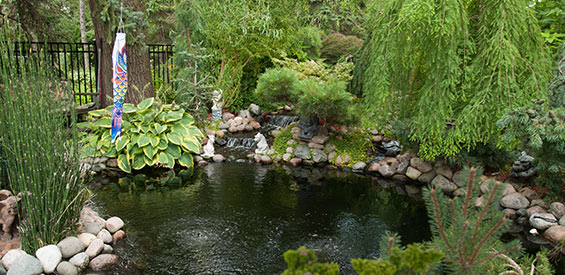
No matter how large or impressive, to create a natural look, a water garden must be in harmony with the larger landscape.
Very rarely do you see in nature an edge or a clear demarcation between two different environments. There is a gradual transition where one environment mingles with another. Softening and blurring the water's edge and gradually extending plant materials into the larger landscape helps create a soothing, uniform pondscape reminiscent of nature.
Create a natural looking water garden by carefully positioning plants in strategic locations. Incorporate the notion of foreground, midground, and background to the proposed pondscape. Use
floating plants and shorter
marginal plants as foreground plants and taller marginal plants and grasses to fill the midground or even the background. Existing shrubs, located further away from the pond, also serve as the background for the entire pondscape.
Positioning shorter plants near the edge of the pond allows an unobstructed view while the gradual planting of taller plants allows a smooth visual transition, gently drawing the eye from the water garden to the greater landscape. The effect is a soothing, unbroken view that makes the water garden a harmonious part of the landscape.
Examine how these particular plants are used based on these basic planting principles to create a water garden that appears natural and effortless.
Care level: easy
Position: foreground or midground
Light: high
Conditions: 64-86°F; pH 5.0-7.5
Propagation: cuttings
Maximum size: up to 5 ft
Zones: 4-11
|
Parrot's Feather (Myriophyllum aquaticum)
Lush textured foliage helps provide shade, shelter, and spawning material for fish. Its feathery blue-green foliage has a velvety sheen and its stems can grow between 20-60 in. as it creeps across the surface of the water. It is a great multifunctional plant that can be grown as a submerged plant or as an emergent plant. Use in crevices in waterfalls, along the edges of your water garden or in wet soil. Plants growing above the water are prone to frost damage but submerged plants winter well beneath the ice.
Care level: easy
Position: midground or background
Light: medium
Conditions: 60-80°F; pH 6.5-7.5
Propagation: runners
Maximum size: up to 3 ft
Zones: 3-11
|
Dwarf Cattail (Typha minima)
Narrow grass-like foliage adds vertical interest to any water garden and its compact form also makes it a great plant for container gardens. Named after its fuzzy dark brown floral spikes, Dwarf Cattails are vigorous growers that can spread rapidly by runners. To maintain a neat appearance and to limit its spread, grow in containers placed under 1-6 in. of water. To winterize, trim foliage down to about 2 in. above soil level or leave intact for winter interest.
Care level: easy
Position: midground or background
Light: high
Conditions: 55-80°F; pH 6.0-9.0
Propagation: rhizomes
Maximum size: up to 5 ft
Zones: 5-11
|
American Lotus (Nelumbo lutea)
Native to Eastern and Central United States, these beautiful plants are a wonderful addition to any water garden. Their large bright yellow blossoms are exotic in appearance and can measure up to 11 in. in diameter with a slight fragrance. Umbrella shaped leaves grow 3 ft. above water, providing texture as well as architectural interest. Requires warm water temperatures around 80°F for consistent blooms. To winterize, trim foliage down to about 2 in. above crown and sink to deeper water.
Care level: easy
Position: foreground
Light: high
Conditions: 70-80°F; pH 6.5-7.5
Propagation: stolons
Maximum size: up to 1 ft
Zones: 9-11
|
Water Hyacinth (Eichornia crassipes)
Produces delicate purple flowers that have a yellow eye on one petal. This floating plant bears leathery foliage that provides shade for fish. Its root system provides filtration, spawning area for fish and absorbs excess nutrients from the water to help reduce algae and clarify water. Thrives in heat and full sun and reproduces vigorously under these conditions. Blooms add a splash of color throughout the growing season. It has a tropical nature and must be brought in for the winter.
Care level: easy
Position: foreground or midground
Light: high
Conditions: 45-75°F; pH 6.1-7.5
Propagation: rhizomes
Maximum size: from 3 to 6 ft
Zones: 4-11
|
Water Lilies (Nymphaea sp.)
The quintessential water garden plant. Generally blooms from June through September with their beautiful flowers floating at the water's surface. Available in a wide range of colors and sizes and has a horizontal growing habit that does best in wide 3-5 gal. potting containers. To winterize, trim foliage down to about 2 in. above crown and sink to deeper water.
|